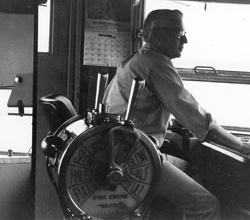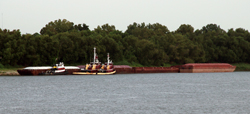Introduction to Delta Pieces: Northeast Louisiana Folklife
Map: Cultural Micro-Regions of the Delta, Northeast Louisiana

The Louisiana Delta: Land of Rivers








Ethnic Groups










Working in the Delta








Homemaking in the Delta



Worshiping in the Delta



Making Music in the Delta




Playing in the Delta







Telling Stories in the Delta



Delta Archival Materials
Bibliography

Big River Traditions: Folklife on the Mississippi
By Ben Sandmel

One of Louisiana's most common stereotypical images is a sternwheel steamboat cruising down the Mississippi River. These vessels haven't functioned as a viable mode of transportation and commerce since the 1930s, and today they operate solely within the tourism industry. But even under those slightly contrived circumstances they preserve a rich body of folklore. Nor are steamboats the only source of folklore, occupational jargon, or oral history that come from the river. Additional examples include the barge industry, commercial fishing, and seasonal events such as levee bonfires.
Each aspect of river life has its own particular traditions, and yet there is plenty of overlap between them, in terms both of specific details and a broader sense of camaraderie. "River people are like a big family," says Ted Ewing, a former towboat deck hand and pilot who went on to work as Port Captain for American Commercial Barge Line in Harahan, Jefferson Parish. "If you mess with one river man," Ewing explains, "you've messed with all of them."
Loyalty is important on the water, since most people who work on riverboats are forced to be around each other for a minimum hitch of thirty days. Some may work for ninety consecutive days or even more. And, as Captain Ewing relates, conditions could and can be quite aggravating: "Back in the early '60s, I caught a boat with an old captain named Bill Keith. This old gentleman didn't have a lot of money. We ran with a crew of four. There was one deck hand—me, one pilot—him, an engineer, and the cook, who turned out to be one of Mr. Keith's ladyfriends. We only ran during daylight hours, 'cause he couldn't afford lights or radar. We tied up to trees at night, and when we left the next morning he knew just where his next tree was where he'd tie up that night. He could just about describe every limb."
"Captain Keith bought very few groceries," Ewing continues. "The places where we tied off were usually near the house of some family who had a big garden, and with their permission we'd get some of their vegetables. We'd catch fish at night. In the morning he'd send me up on the hill. [To a riverman, any dry land is 'up on the hill,' even if it's flat.] I'd go up on the bank and take along his rifle, and I'd shoot squirrels. He'd also have me lay out on the head of the tow with a shotgun while we were going up the river. I'd shoot ducks, and when they floated downstream the engineer'd be standing by the stern with a catch-net. That's how we survived—and one trip was enough for me."
When crew members grow irritable under such conditions, it is said, in river jargon, that they've "got the red ass." This stressful sort of schedule can be avoided by doing "fleet work" on "harbor-," "shift-," or "dinner-bucket" boats, where the crew goes home at night. Such work consists of moving barges between local terminals, or bringing them out to boats that are making long-distance runs. The term for this sort of long-distance work between ports is "tripping." "Tripping" took on a radically different meaning with the emergence of the psychedelic drug culture in the late '60s, but on the river it is still used in its old sense.
The word "fleet" refers not to boats, as might be expected, but rather to groups of barges which are lashed together with steel cables known as "wires." When pushed by a boat, the barges are referred to collectively as "the tow," hence the term "towboat." This term is potentially misleading, since such boats actually push their cargo, as opposed to literally towing it or pulling it from behind. Tows can also be pushed by a tugboat; the difference between the two is that a tugboat has a pointed bow, while a towboat or pushboat has a square bow which can face up flush against the tow.
The steps on the bow of these boats that lead up to the barges are known as the "tow knees." Towboats are designed solely for pushing barges, while tugs perform a number of functions, including helping large ocean vessels steer through crowded areas. Both tugboats and towboats are frequently seen on Louisiana's commercially-navigable waterways.
On all boats, incidentally, the front of the boat is referred to as the "bow," the rear is the "stern," the left side of the boat, facing the bow, is the "port" side, and the right side is "starboard." Anything in the direction of the bow is "forward," while "aft" is toward the stern; floors are known as "decks," walls as "bulkheads," and the kitchen is the "galley."
As with most occupations, much steamboat and towboat jargon is hard to comprehend without a detailed knowledge of deck-work, but some expressions are easily understood. One example is the term "possum"—another name for a braided-rope bumper, which is used to cushion the impact which results when a boat or barge strikes a hard object. Such impact is anticipated, even though the pilot will try to minimize it; it occurs when a boat lands at a dock, for instance, or enters a lock chamber. When held upside down by its rope handle, such bumpers resemble an animal being held by the tail.
Another graphic bit of river terminology is "burying a dead man." When a boat lands in a remote rural area, without docking facilities, it's customary to tie the lines around a good, stout tree. In low-lying areas, however—as are typically found alongside Louisiana rivers—those trees nearest the bank may have unstable, eroded roots. In such cases it is necessary to "bury a dead man," or create a sturdy mooring post by "planting" a stout, perpendicular log at least 8" in diameter, sunk at least 6' d eep in the ground, and extending another 6' above ground level.
The gangplank on a steamboat is known as the "stage," because musical and theatrical performances were often given there on arrival, to drum up business and draw crowds. Today there are very few authentic, steam-powered sternwheel boats still in existence, and four of the best-known ones—the Delta Queen, Mississippi Queen, American Queen, and the Natchez—are all based in New Orleans. Steamboat travel reached its peak in the late 19th century, when it was the preferred mode of transportation for both goods and passengers. But improved rail and road service blunted the steamboats' competitive edge. With a tradition of on-board entertainment already firmly established, it was a logical step for many steamboat owners to make this the focus of their business.
Captain Clarke "Doc" Hawley, a career river pilot and calliope player, recently retired from the Natchez, explains that "when the freight and passenger business went by the wayside, the packet-boat captains tore out their staterooms and put in dance-floors and ballrooms." This ushered in a phase of river history known as the tramp-boat era. "Tramp boats were popular," Hawley says, "in the days before air-conditioning and television.
"Tramp boats had no particular home port. They went from town to town, river to river, doing what the Natchez does in New Orleans—taking people out for a river-boat excursion. I worked on one of the last of the tramp boats, the Avalon which laid up in 1961. We went everywhere in between New Orleans; Omaha, on the Missouri River; Nashville, on the Cumberland; Kingston, Tennessee on the French Broad; Charleston, West Virginia, on the Kanawha; and Pittsburgh, on the Ohio. Tramp boats served the great purpose of entertaining people. We'd pull into little towns that didn't even have a newspaper, let alone a television station, and when we'd start playing the calliope, people would come from miles around. In those days, middle America didn't have much entertainment at home, and the only way of cooling off was to sit out on the front porch swing. We provided entertainment and a nice breeze off the river. Once people could sit in air-conditioned comfort and watch Milton Berle on the tube, our purpose was replaced, and the business started dying."
Such entertainment traditions survive on the remaining steamboats, and the tramp-boat entertainment tradition maintains significant and varied folk roots even in its present state of commercialized nostalgia. It is also a rich source of oral history. Vic Tooker, a brilliant multi-instrumentalist and lifetime steamboat entertainer, was raised in the thick of this tradition: "My dad, grandfather, and great-grandfather all played four-string show-boat banjo on the steamboats, among many other instruments, and my great-grandfather was also the captain of the Lizzie Castle, which pushed show boats on the Mississippi and Ohio Rivers. I spent seventeen years as the interlocutor, which is something like a combination emcee and social director, on the Delta Queen. I guess I have this in my blood—it's like a disease. I read music, but as Louis Armstrong said, 'not enough to interfere with the enjoyment of my playing.' The finale of my act used to be playing 'Tiger Rag' on five instruments at once. I'd play the accordion with my left hand, the xylophone with three mallets in my right hand, the harmonica in my mouth with a neck rack, the bass drum with my right foot, and a sock cymbal with my left foot."
For over a century the Christmas Eve levee bonfires of St. James Parish have shone as one of south Louisiana's most unique holiday traditions. The fires' origin is a matter of some debate, and the different explanations offered illustrate the folkloric process at work. One school of thought cites the whimsical purpose of lighting the way for Papa Noel. The more pragmatic explanation of marking the route to Christmas Eve mass, in a season known for fog, is also offered. Louisiana folklorist Barry Ancelet explains that such theories "were made up after the fact. It's more likely that the bonfires' function is purely celebratory. The tradition dates back to pre-Christian Europe, when the Celts built bonfires to celebrate the winter solstice, and to encourage the sun to survive until springtime."
The popularity of the bonfire tradition has grown significantly in recent years. Christmas Eve festivities on the levee in Gramercy now attract thousands of people, and stretch on for several miles. Most of the fires are built in tall, conical shapes, although others depict plantation homes, airplanes, or various items from current popular culture. After months of hard work, the fires are lit, illuminating the landscape and also igniting raucous parties. In an interesting case of one folkloric tradition stimulating another, New Orleans-based steamboats now run special excursions to view the bonfires from the water. Prior to this recent development, steamboats probably had not called at Gramercy since before World War II.
River lore also includes waterfront work songs, occupational practices such as lead-line calling (the source of the term "mark twain"), the nomadic lifestyle of people who live on shantyboats, and water front work songs. While life on Louisiana's rivers has lost some of its more romanticized trappings, it is still a rich source of folklore.




